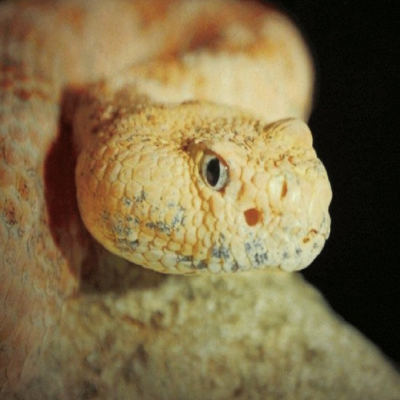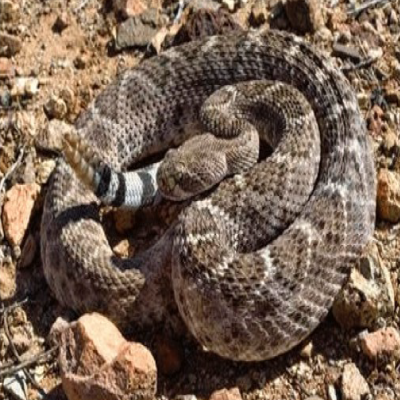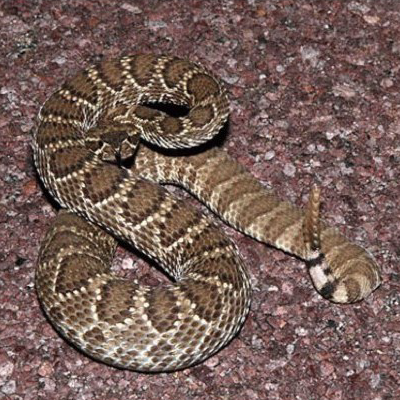There are 17 species or subspecies of rattlesnakes in Arizona and they all object to being stepped on. So watch where you walk. In my field experience as a geologist, I’ve encountered many rattlesnakes, and most of the time they don’t rattle. They prefer to remain inconspicuous. See here for a list of all recognized rattlesnake species and subspecies. By the way, my record rattlesnake encounter is sighting 26 in one morning on a property along the Kelvin Road east of Florence.

Photo by Jonathan DuHamel from ASDM exhibit
Some herpetologists regard rattlesnakes as one of the most highly specialized animals on the planet. The venom, a toxic saliva, is a complex mixture of enzymes that include hemotoxins, that attack the blood and start the digestion process in tissue, and anticoagulants. The Mohave and Tiger rattlesnakes also carry neurotoxic venom that may cause circulatory arrest or respiratory paralysis. That said, however, fewer than 1% of people bitten in the U.S. die as a result of the bite, but many sustain tissue damage. About 20% of defensive bites are dry – no venom injected. Venom is injected via curved fangs which fold back into the snake’s mouth. Rattlesnakes seem to have spare parts to replace damaged fangs. Baby rattlesnakes are venomous and ready to go, they just can’t inject as much venom as a larger snake.
If you are bitten, the University of Arizona College of Pharmacy recommends that you get to a hospital to get antivenom and treatment for tissue damage. Don’t bring the snake; the antivenom treats all bites. Also don’t use tourniquets, that just concentrates the venom and produces more tissue damage. Don’t use ice for the same reason. Don’t cut and suck; you can’t get enough venom out to make a difference, and, if a friend does it for you, he takes a chance of envenomating himself. Do remove tight clothing, shoes, jewelry from the affected limb.
Rattlesnakes are pit vipers, which means they have heat-sensing organs located between their eyes and nose. A rattlesnake can detect the heat of a candle at 30 feet. Some researchers claim that a rattlesnake can perceive a temperature difference of as little as 0.01 degree Fahrenheit at one foot. The snakes use this heat-sensing ability in several ways. They can follow the heat trail of prey even in total darkness. They can tell if an animal is too large to be prey and thereby avoid it. And, the exothermic (cold-blooded) snake can use their temperature sensor to help find places to properly regulate body temperature.
Rattlesnakes are most active in the warmer times of year, but in Arizona, they may be out and about any time the temperature is between 70 and 90 degrees F.
Rattlesnakes are born live, rather than hatch from eggs. The babies have the first segment of the rattle, but can’t make a noise until it sheds and gets another bead on its rattle. Mother rattlesnakes care for their young at least until after the first shed. It is a myth that you can tell the age of a snake by counting the beads on the rattle. Beads are added at each shed, and the snake may shed several times a year. The rattle material is keratin, the same as your fingernails. There isn’t anything inside the rattles; the noise comes from the segments bumping against each other as the snake vibrates its tail up to 60 times per second.
Rattlesnake eyes have slit pupils like cat eyes. The gopher snake, a non-venomous constrictor, is often mistaken for a rattlesnake, but it has round pupils and lacks the triangular head of the rattlesnake.
Other snake myths. Snakes cannot dislocate their jaws. They can open their mouths very wide because they have two jaw joints on each side separated by a (quadrate) bone. Snakes also lack bony chins. Each half of the lower jaw is separated by cartilage which enables the snake to move the lower jaw halves independently.
Rodents are the main prey of the rattlesnakes, so the snakes provide a valuable service. They also take birds, lizards, and baby rabbits and squirrels.
At the Arizona-Sonora Desert Museum, (ASDM) the staff capture an average of 100 rattlesnakes per year on the grounds. After capture, the snakes are marked by color-coding the tails and, more recently, by inserting a radio chip to allow tracking. The snakes are released on the far reaches of the grounds. Rattlesnakes, however, are very territorial, so many return. So, if you are at the Museum and see a rattlesnake with a multi-colored tail, you will know that particular snake is a return visitor. And no human visitors have ever been bitten by a rattlesnake at the Museum.
Speckled rattlesnakes, such as the one in the first photo above, most commonly inhabit dry, rocky, granite-filled canyons and their speckles resemble rock pattern and color, giving the snakes camouflage. Speckled rattlesnakes come in several colors including white, orange, pink, blue, tan, silver, black, and gray. They are generally small, 2- to 3 feet, but one subspecies can be up to 5 feet long. Their range includes Central and Western Arizona, Southeast California, Northwest Sonora, Baja California, and several islands in the Gulf of California. See more photos here.

Photo credit: Manny Rubio
Arizona-Sonora Desert Museum digital library
The Western Diamondback rattlesnake is probably the most common because it is a generalist and occupies many different habitats from sea level to 6,500 feet in elevation. See more photos here.

Photo credit: Gary Nafis
Arizona-Sonora Desert Museum digital library
The Mohave rattlesnake (see more photos here) appears very similar to the Western Diamondback. There is some minor difference in tail banding. According to ASDM, this snake “prefers open areas with grasses, creosote bush, palo verde, mesquite and cactus; most common at lower elevations; also common in desert grasslands of southeast Arizona; usually not present in rocky areas or areas with heavy vegetation.”

Photo credit: Howard Byrne III
Arizona-Sonora Desert Museum digital library
The Tiger rattlesnake (see more photos here) is, according to ASDM, “strictly a Sonoran Desert region species; most common in very rocky canyons and foothills or arid desert mountains up to 4800 feet (1460 m); usually restricted to cactus and mesquite of the rocky foothills; seldom encountered in flat, sandy areas devoid of rocks.”
See my other natural history posts on ADI:
Palo Verde trees about to turn the desert golden
Cactus water will make you sick
Mesquite trees provide food, fuel, medicine, and more
Thirteen venomous animals of the Southwestern desert
Pepsis wasps have the most painful sting
Nighthawks and Poorwills, birds of the night
Chapter 1, Precambrian, when Arizona was at the south pole
Chapter 2, Cambrian to Ordovician time, Arizona’s tropical beaches and an ice age
Chapter 3, Silurian to Permian time, more tropical beaches and another ice age
Chapter 4, Triassic Period, volcanoes, dinosaurs, and petrified wood
Chapter 5, Jurassic Period, more dinosaurs and birth of Atlantic Ocean
Chapter 6, Cretaceous Period, coal, copper, and bad news for dinosaurs
Chapter 7, Cenozoic Era, much volcanism as Arizona was squeezed, stretched; steamed and frozen
Copyrighted by Jonathan DuHamel. Reprint is permitted provided that credit of authorship is provided and linked back to the source.
